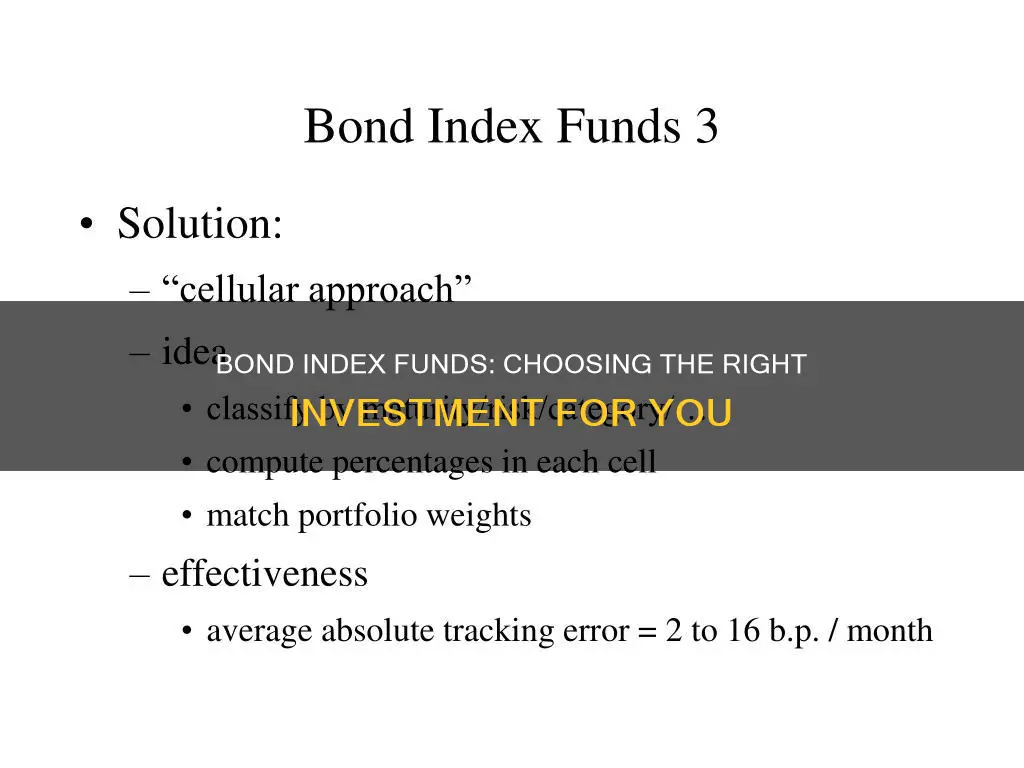
Choosing a bond index fund can be a challenging puzzle for many people. The bond market is complex, and there are many different types of bond funds available, from government and corporate bond funds to high-yield and short-term bond funds. When deciding which bond index fund to invest in, it is important to consider factors such as the fund's benchmark index, level of diversification, expense ratio, minimum investment requirements, and the types of bonds included in the fund's portfolio.
What You'll Learn

Short-term bond index funds
One example of a short-term bond index fund is the Schwab Short-Term Bond Index Fund (SWSBX). This fund aims to track the performance of an index composed of US investment-grade government-related and corporate bonds with maturities of one to five years. It has a low expense ratio of 0.060% and no minimum investment requirement, making it accessible to a wide range of investors.
Another option is the Fidelity Short-Term Bond Index Fund (FNSOX). While specific details about this fund are scarce, it is likely to have similar characteristics to the Schwab offering, with a focus on short-term, high-quality bonds.
When considering short-term bond index funds, it is essential to evaluate the fund's holdings, expense ratio, diversification, and investment minimums to ensure they align with your financial goals and risk tolerance.
HOA Funds: Where to Invest for Maximum Returns
You may want to see also

High-yield bond funds
Potential Benefits of High-Yield Bond Funds
- Higher Returns: High-yield bond funds offer the potential for higher returns compared to investment-grade bonds. The bonds with the highest risks usually have the highest yields.
- Diversification: These funds can provide diversification benefits to an investment portfolio. They typically have a low correlation with other sectors of the fixed-income market, which can help reduce overall portfolio risk and improve the consistency of returns.
- Capital Appreciation: In the event of an economic upturn or improved performance of the issuing company, high-yield bond prices can appreciate significantly, providing capital gains on top of the interest income.
- Equity-like Returns: High-yield bonds tend to respond similarly to the overall market environment as equities, leading to similar return profiles over a full market cycle. However, the returns on high-yield bonds tend to be less volatile due to the larger income component.
Potential Risks of High-Yield Bond Funds
- Default Risk: High-yield bonds have a higher risk of default compared to investment-grade bonds. This is the most significant risk for investors, and diversification is a common strategy to mitigate this risk.
- Volatility: The prices of high-yield bonds are more volatile than investment-grade bonds and can fluctuate significantly in response to changes in the economic environment or the issuing company's performance.
- Interest Rate Risk: All bonds face interest rate risk, but high-yield bonds are particularly sensitive to changes in market interest rates. When interest rates rise, the market value of high-yield bonds can decline as investors move towards newer bonds with higher returns.
- Liquidity Risk: High-yield bonds generally have higher liquidity risk, which means that investors may not be able to sell them easily at the desired price and time.
When considering investing in high-yield bond funds, it is essential to assess your financial situation, including your income, net worth, investment goals, and risk tolerance. These funds may be suitable for investors with a high-risk tolerance and a long-term investment horizon.
IRA Investment Options: Mutual Funds or ETFs?
You may want to see also

Municipal-bond funds
Municipal bonds are debt obligations issued by public entities, such as states, cities, and counties, to finance public projects like schools, hospitals, and highways. They are generally considered a safe investment, but there are risks to consider, and they may not be suitable for all investors.
Municipal bonds typically fall into one of two categories: general obligation bonds or revenue bonds. General obligation bonds are issued by governmental entities and are backed by the "full faith and credit" of the issuer, which has the power to tax residents to pay bondholders. Revenue bonds, on the other hand, are secured by revenues generated by the issuer or by certain taxes, such as sales or fuel taxes.
Municipal bonds offer several benefits, including tax advantages. The interest income from municipal bonds is generally exempt from federal income tax and, in some cases, state and local income taxes as well. This makes them particularly attractive to investors in higher tax brackets. Additionally, municipal bonds have a low level of default risk compared to other bond types.
However, there are also risks associated with investing in municipal bonds. These include interest rate risk, call risk, reinvestment risk, credit/default risk, and liquidity risk. It's important for investors to carefully consider these risks and their own financial goals and risk tolerance before investing in municipal bonds.
When considering municipal-bond funds as an investment option, it's crucial to evaluate the fund's specifics, such as the creditworthiness of the issuers, the diversity of the portfolio, and the associated fees and expenses. Additionally, investors should keep in mind that not all municipal bonds are tax-exempt, and there may be tax consequences when buying, selling, or owning these bonds.
Pension Funds: Where Are Your Retirement Savings Invested?
You may want to see also

Total bond market index funds
When choosing a total bond market index fund, it is important to consider the fund's benchmark index, level of diversification, net expense ratio, and other factors. Here are some of the best total bond market index funds to consider:
Fidelity U.S. Bond Index Fund (FXNAX)
FXNAX is Fidelity's flagship bond fund, with a history dating back to 1990. The fund has accumulated over $56.7 billion in total assets and follows the Bloomberg U.S. Aggregate Bond Index as its benchmark. It employs a sampling technique to replicate the index's returns and has an average duration of 6.21 years, typical of total bond market index funds. FXNAX has no minimum investment requirement, transaction fees, or sales loads, and boasts an incredibly low expense ratio of 0.025%.
Vanguard Total Bond Market Index Fund Admiral Shares (VBTLX)
As the counterpart to Vanguard's popular total stock market index fund, VBTLX has a slightly shorter track record than FXNAX but boasts an impressive $318.5 billion in assets for the Admiral Shares class. The fund has an expense ratio of 0.05%, which is still considered low, and has been tracking a modified version of the Bloomberg U.S. Aggregate Bond Index since 2010. VBTLX's portfolio includes more than 10,000 bonds, with an average duration of 6.6 years, spanning both government and investment-grade corporate issues. However, it does require a $3,000 minimum investment.
Schwab U.S. Aggregate Bond Index Fund (SWAGX)
SWAGX offers straightforward, transparent, and affordable exposure to over 8,000 investment-grade government and corporate bonds from the U.S. market. It has an average duration of 6.2 years and tracks the popular Bloomberg U.S. Aggregate Bond Index. Schwab does not require a minimum investment or charge a 12b-1 fee for this fund. SWAGX has a low expense ratio of 0.04% but has a shorter track record, having launched in 2017.
Northern Bond Index Fund (NOBOX)
NOBOX is another option for exposure to the benchmark Bloomberg U.S. Aggregate Bond Index. The fund includes U.S. Treasurys, agency bonds, mortgage-backed securities, and investment-grade corporate bonds. With over 2,400 holdings, NOBOX has a lower number of bonds than the others on this list but features an average duration of 6.6 years. It has a long track record of performance since 2007 and a low expense ratio of 0.07%. NOBOX offers broad diversification but requires a minimum investment of $2,500.
IShares U.S. Aggregate Bond Index Fund (BMOAX)
BMOAX, offered by BlackRock iShares, tracks a broad portfolio of U.S. Treasurys, agency bonds, mortgage-backed securities, and investment-grade corporate bonds, with an average duration of 6.42 years. This fund provides the usual broad diversification for the U.S. bond market and has a decent track record, having launched in 2011. BMOAX has a higher expense ratio of 0.35% and requires a minimum investment of $1,000.
T. Rowe Price QM U.S. Bond Index Fund (PBDIX)
PBDIX tracks the Bloomberg U.S. Aggregate Bond Index with a slight twist. While it primarily selects bonds that represent key benchmark traits, the fund manager also attempts to generate a modest amount of outperformance over the index. PBDIX has a long track record, having launched in November 2000, and offers broad diversification. It is offered with no transaction fees at several major brokerages and has an expense ratio of 0.25%. However, it has lower assets of $1.4 billion and requires a $2,500 minimum investment with subsequent investments of at least $100.
Actively Managed Funds: Where to Invest Your Money?
You may want to see also

Intermediate core bond index funds
When considering intermediate core bond index funds, it's important to understand the benefits and risks of such investments. Intermediate core bond funds offer a good balance of risk and return, making them attractive to investors seeking a blend of both. Here is a detailed overview of some intermediate core bond index funds to consider:
Vanguard Total Bond Market Index Fund Admiral Shares (VBTLX)
VBTLX is Vanguard's counterpart to their popular total stock market index fund. With assets under management of $318.5 billion for the Admiral Shares class, it has a strong track record since its inception in 2001. The fund's expense ratio is 0.05%, which is still considered low, resulting in minimal fees. VBTLX tracks a modified version of the Bloomberg U.S. Aggregate Bond Index, investing in over 10,000 bonds with an average duration of 6.6 years. The portfolio includes government and investment-grade corporate bonds, offering a well-diversified option.
Fidelity U.S. Bond Index Fund (FXNAX)
FXNAX is Fidelity's flagship bond fund, with a long history dating back to 1990. It has accumulated over $56.7 billion in total assets. This fund follows the Bloomberg U.S. Aggregate Bond Index and aims to replicate its performance through a sampling technique. FXNAX has an average duration of 6.21 years, typical of intermediate-term bond funds, and a meagre expense ratio of 0.025%. There is no minimum investment required, and the fund excludes high-yield bonds and tax-exempt municipal bonds.
Schwab U.S. Aggregate Bond Index Fund (SWAGX)
SWAGX offers straightforward and transparent exposure to over 8,000 investment-grade government and corporate bonds from the U.S. market. With an expense ratio of 0.04% and no minimum investment required, it is an affordable option. The fund has a shorter track record, having launched in 2017, but maintains the usual intermediate duration of 6.2 years. However, it has limited exposure to municipal bonds and no exposure to high-yield bonds.
Northern Bond Index Fund (NOBOX)
NOBOX is another option for exposure to the benchmark Bloomberg U.S. Aggregate Bond Index. The fund includes U.S. Treasuries, agency bonds, mortgage-backed securities, and investment-grade corporate bonds. With over 2,400 holdings and an average duration of 6.6 years, it offers broad diversification. NOBOX has a long track record of performance since 2007 and a low expense ratio of 0.07%. However, it requires a minimum investment of $2,500 and has limited exposure to municipal bonds.
IShares U.S. Aggregate Bond Index Fund (BMOAX)
BMOAX, offered by BlackRock iShares, tracks a broad portfolio of U.S. Treasuries, agency bonds, mortgage-backed securities, and investment-grade corporate bonds. The fund has an average duration of 6.42 years and a decent track record since its inception in 2011. BMOAX provides broad diversification but has a higher expense ratio of 0.35% and requires a minimum investment of $1,000. It also does not offer exposure to high-yield bonds or TIPS.
TIAA-CREF Bond Index Advisor (TBIAX)
TBIAX is a core U.S. bond index fund that tracks the Bloomberg Barclay's U.S. Aggregate Bond Index. It aims to generate total returns primarily from income, investing in a wide range of intermediate-term debt. With over 8,500 bonds, including government securities and mortgage-backed securities, TBIAX is highly diversified. The fund has an average effective duration of about six years and a strategy to minimise trading costs.
It is important to conduct thorough research and consider your financial goals and risk tolerance before investing in any of these funds. Additionally, remember that the bond market can be complex, and it's essential to understand the risks and potential returns associated with intermediate core bond index funds.
Covered Funds: A Smart Investment Strategy?
You may want to see also
Frequently asked questions
Some of the best bond index funds to invest in include the Fidelity U.S. Bond Index Fund (FXNAX), Vanguard Total Bond Market Index Fund Admiral Shares (VBTLX), Schwab U.S. Aggregate Bond Index Fund (SWAGX), Northern Bond Index Fund (NOBOX), and iShares U.S. Aggregate Bond Index Fund (BMOAX).
When choosing a bond index fund, consider factors such as the fund's benchmark index, level of diversification, expense ratio, minimum investment required, and the types of bonds included in the fund.
Bond index funds offer a diversified portfolio of bonds with different credit qualities and maturities, providing a good core foundation for your investment portfolio. They tend to have low expense ratios and no additional fees or charges.
You can profit from a bond index fund through interest income, as the underlying bonds pay interest, and capital appreciation, as the price of the bonds can increase due to factors such as improvements in credit conditions or falling interest rates.
Bond index funds do not mature like individual bonds, resulting in greater interest rate risk. They also offer broad exposure to different types of bonds, which may not be suitable for investors seeking more focused exposure to specific bond types. Additionally, bond index funds may exclude certain niche bonds, such as Treasury-Inflation Protected Securities and tax-exempt municipal bonds.







